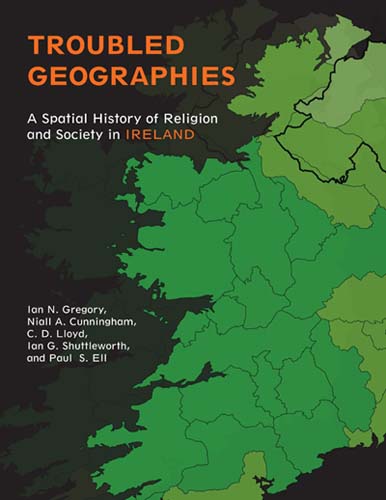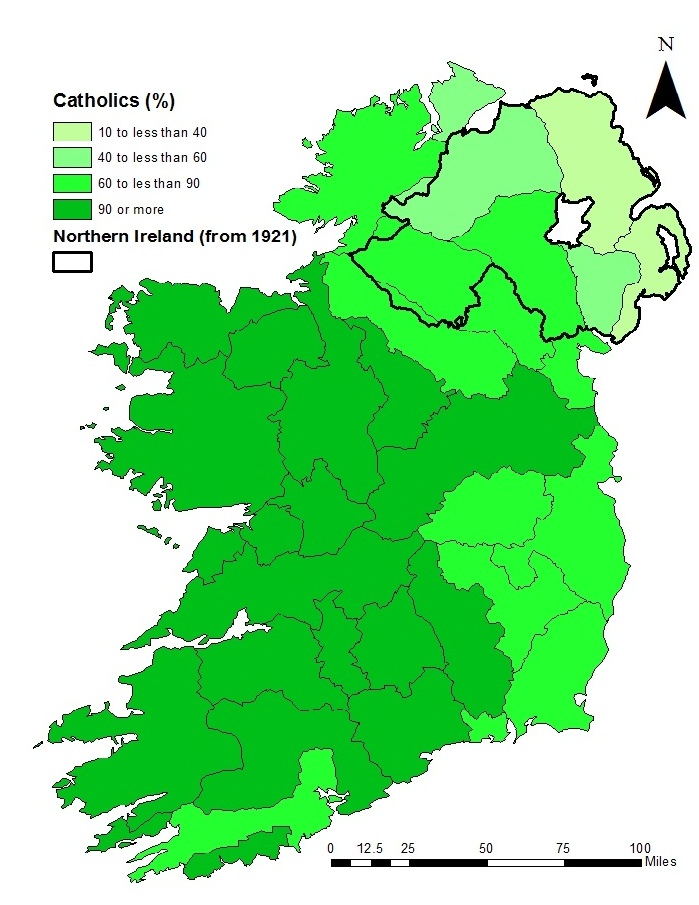Troubled Geographies:
A Spatial History of Religion
and Society in Ireland

Troubled Geographies:
|
 |
| Full text available from Indiana University Press | |||||||||||||||||
|---|---|---|---|---|---|---|---|---|---|---|---|---|---|---|---|---|---|
12. Conclusions: Ireland's religious geographies - stability or change?Looking backward

Fig 12.1: Catholic populations in (a) 1834 and (b) 2001/2. The 2001/2 data have been interpolated onto the diocese used by the 1834 Royal Commission. Figure 12.1 shows the distribution of Catholics in 1834 and compares this with their distribution in 2001/2 as interpolated onto 1834 Church of Ireland dioceses. In many ways very little has changed and these maps actually understate the degree of long-term spatio-religious stability as these geographies were laid down in the plantation period over two centuries before the 1834 survey. This period of immigration and colonization left the geographies that are still clearly apparent today and left a legacy of division and interdependence between Catholics and Protestants and an intertwining of religion, ethno-national identity, and political opinion which has periodically flared into violence. Conversely, these maps may also overstate the degree of stability because dioceses are aggregate units whic can conceal patterns of concentration and more localized change. Nevertheless, this degree of stability appears remarkable. From 1834 to 2001/2 only three dioceses containing approximately 7.5 percent of the population at both dates saw the Catholic proportion of their population change by more than ten percentage points. Of these, Raphoe and Derry in west Ulster saw their Catholic populations rise, while the tiny diocese of Kilfenora on the southern shore of Galway Bay saw its Catholic population decline. 
Fig 12.2: Percentage population change between 1834 and 2001/2. The 2001/2 data have been interpolated onto the diocese used by the 1834 Royal Commission. While there has been much stability, it is wrong to say that there has been little change. Ireland's population fell by 28 percent from 1834 to 2001/2, driven particularly by emigration. As figure 12.2 shows, the effects of this loss have not been even. Connor, Down and Dublin saw large population increases as a result of the growth of Belfast and Dublin. Of the remaining 29 dioceses, twenty - covering the vast majority of the west and the midlands - have experienced population declines of over fifty percent. It seems likely that a major cause of this pattern has been people migrating out of overwhelmingly Catholic rural areas. Some of this has been emigration which has contributed to the decline in the overall Catholic proportion of the population. Some of the rest has been rural-urban migration, often into the cities and towns that were the Protestant heartlands. This means that demographic change over the two centuries has meant that Catholics and Protestants now live in much closer proximity than they did previously. However, while demography may have moved the two groups closer together, the combination of religious and ethno-national identity and politics have done much to keep them apart. 
Fig 12.3: The size of the minority populations of the two parts of Ireland from 1861 to 2001/2. RoI Non-Catholic: Non-Catholics in the (modern) Republic of Ireland, NI Catholic: Catholics in (modern) Northern Ireland. Note that the 1981 figure for Catholics in Northern Ireland must be treated with caution due to problems with this census. Figure 12.3 shows the demographic trends of the minority religions in the two parts of Ireland. The Protestant minority in the south contributed a little over ten percent of the population until Partition. Immediately after Partition it declined sharply, a decline which continued until 1961. Since then, the non-Catholic share of the Republic's population has increased significantly and, in 2002, had risen to pre-Partition levels. This increase reflects the secularization and immigration that accompanied economic progress. In Northern Ireland, conversely, the Catholic population was declining in the pre-Partition period but stabilized afterwards at around 34 percent. While there was a slight upward trend in this until 1961, the start of the Troubles seems to have coincided with, and probably contributed to, a sharp loss of Catholics from the north. As discussed in chapter 9, figures for Catholics from the 1981 Northern Ireland census are unreliable but by 1991 an upward trend had resumed and, by 2001, the proportion of Catholics in these six counties was higher than it had been since the nineteenth century. Future trajectories: Moving apart or moving together?This book finishes with the censuses of 2001/2, a time when both parts of Ireland were very much at a crossroads. In Northern Ireland the early stages of the peace process showed encouraging but there were still major questions about whether it would lead to a lasting peace. The Republic, by contrast, showed a very optimistic picture with the Celtic Tiger economy appearing to have achieved little short of an economic miracle. A decade later the situation is, if anything, more confused. The Northern Ireland peace process has, despite some setbacks, been solid and the political power-sharing system that it brought in also appears relatively stable. At a more day-to-day level, however, the situation is less encouraging and in many ways, spatio-religious divides are still in many ways as stark as they were during the Troubles. At the same time, it is beginning to become true to say that there is no longer a clear zero-sum game in Northern Ireland's religions between Catholics and Protestants. Recent years have seen immigration into Northern Ireland, albeit at a far lower level than other parts of the UK, and there are increasing minorities from east Asia, south Asia and eastern Europe in particular. Northern Ireland will have to adapt to having two major cultures and a significant number of more minor ones. If religion on both sides of the divide continues to dominate community identity and political opinion this may prove difficult. If all groups are able to benefit, economic success has the potential to be an important factor in turning Northern Ireland into a more cohesive society. There have been encouraging signs as the economy emerges from the Troubles as regeneration in Belfast city center and the Titanic Quarter show. However, Northern Ireland's economy still remains heavily dependent on the public sector. The contraction of public sector spending after the financial crisis of 2008 has major implications for Northern Ireland's prosperity which, in turn, may have significant implications for a cohesive society. In the lead up to 2008 the Celtic Tiger brought with it a successful, rich and diverse economy that turned an ethos of emigration into one of immigration. At the same time, the child abuse scandals within the Catholic Church and the ongoing rise in secularization have continued to weaken the influence of Catholicism. Thus, the days when the Republic was an overwhelmingly Catholic state, in terms of numbers and, more particularly, the power of the Church, have gone. The link between Catholicism and nationality which was forged in the nineteenth century, has also been broken. The sense of Irish identity which largely conceived of itself in a post-colonial opposition to Britishness, has largely disappeared as the Irish state and its economy have matured. With this, the geographies of religion have become increasingly irrelevant. Thus, in the Republic and in Northern Ireland, the old certainties provided by religion have been deconstructed, to be replaced by a more inclusive, but also more hesitant form of identity. So far this discussion has concentrated on two Irelands rather than one. These two have had different trajectories during the twentieth century and we have speculated on their individual futures. This poses the question of whether there is any chance of a single Ireland re-emerging. At a political level this seems unlikely, however formal cross-border links are increasing and informal evidence suggests that more and more people are crossing the border for business and for pleasure. Links between the UK and the Republic have become ever stronger and increasingly Ireland and the U.K. have become partners within the E.U., developing ever stronger economic and political ties. Economically, the old dichotomy between an agricultural south and a manufacturing-based north has collapsed as both economies have increasingly converged around the service sector, increasing a degree of interdependence between the two which is only likely to grow further. Thus, while the border will remain, the rift that it represented may be diminishing as the religious, identity, political and economic divides that created it become increasingly irrelevant. |
|||||||||||||||||
©Ian Gregory & Niall Cunningham, 2013